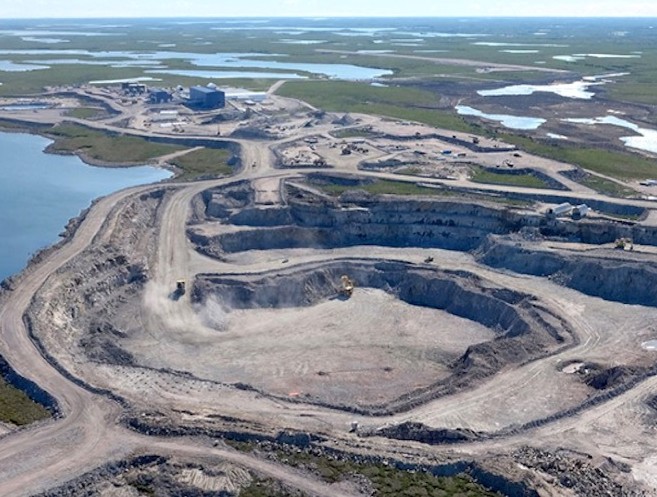What is SCO2UT?
In the SCO2UT (Sequestration of CO2 in Ultramafic Tailings) research program, we work with partners in the mining industry to sequester CO2 in mine waste. Some mine sites that are hosted in ultramafic rocks have the potential to capture carbon directly from mine emissions or from the atmosphere, offsetting emissions and producing carbon offset credits. The key to realizing this opportunity is to identify the carbon mineralization potential of a mine site, and then to implement strategies and technology to maximize carbon uptake in mine waste. This is where SCO2UT comes in.
Geologic Background
Many ore deposits are hosted in ultramafic rock, which is rock typically formed in the mantle and characterized by low silica (<45 wt%) and high magnesium and iron oxide (>18 wt%) content. Due to their chemical makeup and alteration during uplift or intrusion to the Earth’s surface, these ultramafic rocks have a high potential to react with CO2 to form carbonate minerals and offset the greenhouse gas emissions of mining activities and beyond.
In SCO2UT, there are two ultramafic rock types that we focus on: kimberlite and serpentinite. Kimberlite rocks host diamonds, while serpentinite often hosts nickel and platinum group metals.
During the mining process, rock is excavated and crushed, the commodity is recovered, and the leftover rock is then typically stored in large piles or ponds as waste, known as mine tailings. Typically, the tailings have no further use and simply must be managed as waste. Now, mine tailings present an opportunity to both sequester CO2 and create a new revenue stream for mining companies through carbon offset programs.

SCO2UT Projects
We have several ongoing partnerships with mining companies in Canada and around the world. Some of our projects are featured below.
Gahcho Kué Diamond Mine (NWT, Canada)

Gahcho Kué is a diamond mine located in the Northwest Territories, Canada, owned and operated by De Beers Canada. It is the site of the first ever enhanced carbon mineralization field pilot at an active mine site, conducted in 2019 by CarbMin researchers.
Two experiments were conducted at Gahcho Kué in 2019. In the first experiment, CO2 gas was injected into a six meter-long kimberlite tailings pipe. CO2 concentration measurements were taken at the beginning, middle, and end of the pipe. CO2 concentrations were lower at the middle and end of the pipe, demonstrating CO2 had been trapped by the kimberlite waste rock throughout the pipe. Samples of the kimberlite waste rock were collected for geochemical analysis at UBC to quantify exactly how much CO2 was trapped. The second experiment involved injecting CO2 gas into a cubic meter of kimberlite waste rock that was strategically compiled with layers of fine, coarse, and a mixture of fine and coarse waste rock materials. In this experiment, reactivity of the different layers was assessed and the manipulation of fine and coarse layers was tested to determine the perfect mix for trapping CO2.
A second field demonstration at larger scale was scheduled at Gahcho Kué for 2020, but was postponed due the Covid-19 pandemic. Ongoing lab work continues using kimberlite tailings shipped to UBC, refining understanding on the controls of reactivity rates and mechanisms for flue gas delivery.
Decar Nickel District (BC, Canada)

The Decar Nickel District is a greenfield nickel discovery, a promising target for nickel mining owned by FPX Nickel Corp. As an undeveloped deposit in serpentinite host rock, a mine here would have the opportunity to incorporate carbon mineralization strategies directly into its infrastructure and management plans from the beginning, rather than retrofitting to an active mine site. Decar hosts a nickel-iron alloy, called awaruite, and the district contains very low levels of potentially polluting and oxygen-reactive sulfide minerals. The low sulfide levels, combined with the host rock’s CO2 sequestration potential, make it well suited for atmospheric CO2 capture.
The CarbMin Lab works with FPX to assess the co-occurrence awaruite and reactive minerals that would enhance carbon mineralization. A field pilot was conducted in the summer of 2020 using host rock material from the Baptiste deposit, a locale within the Decar Nickel District, to determine the reactivity of potential mine tailings at this site. The experiment used several hundred kilograms of crushed serpentinized rock, divided into sections that were manipulated to determine the effects of different variables such as rainfall on the carbon uptake of the material.
Turnagain Nickel property (BC, Canada)
The Turnagain Nickel Property, located in north-central BC approximately 70 km east of the community of Dease Lake, hosts a significant nickel resource. The property is owned by GigaMetals Corporation, who are collaborating with the CarbMin Lab to determine the carbon mineralization opportunity of the ultramafic host rock. Detailed geological mapping and exploration geophysical surveys have been conducted at this site due to its history of exploration, and researchers are currently conducting mineralogical studies to understand the distribution of relevant minerals within Giga’s Turnagain deposit. A future field experiment is planned to assess the carbon mineralization potential of Turnagain ultramafic material.
De Beers Diamond Mines (South Africa)
The CarbMin Lab partners with the De Beers Group to conduct research at several South Africa mines, including Venetia Diamond Mine, Cullinan Diamond Mine, and Voorspoed Diamond Mine, as part of the De Beers CarbonVaultTM program. CarbMin researchers examine the heterogeneity of kimberlite deposits to determine where the most reactive (for carbon mineralization) material is found, develop analytical methodology for measuring reactive material content within kimberlite waste samples, conduct experiments on mine-specific kimberlite waste rock, and overall work to lay the groundwork for large-scale utilization of carbon mineralization to sequester CO2 at De Beers mines.